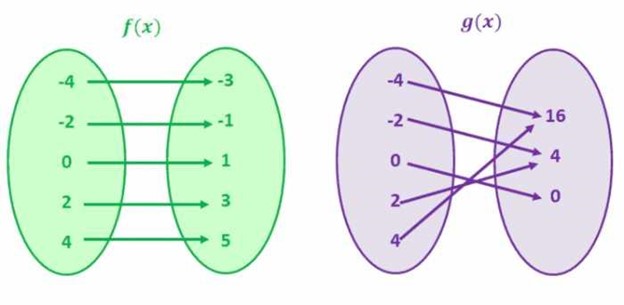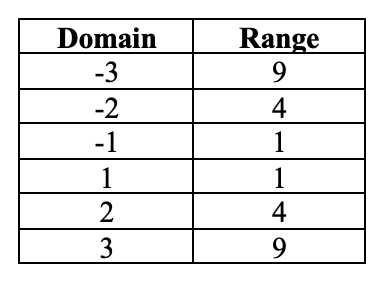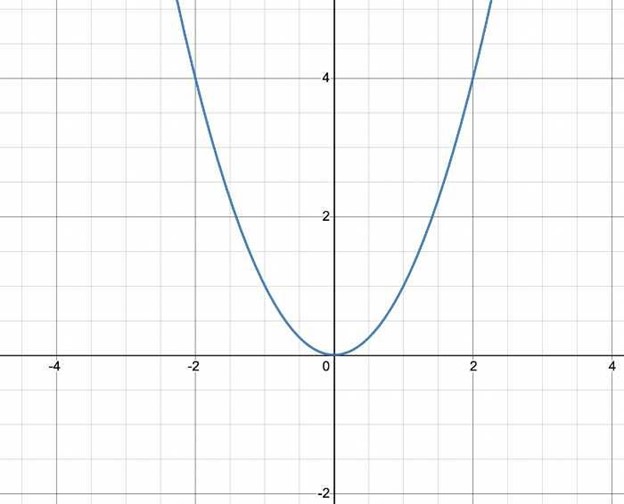One to One Functions - Graph, Examples | Horizontal Line Test
What is a One to One Function?
A one-to-one function is a mathematical function whereby each input corresponds to just one output. So, for each x, there is just one y and vice versa. This signifies that the graph of a one-to-one function will never intersect.
The input value in a one-to-one function is the domain of the function, and the output value is the range of the function.
Let's study the images below:

For f(x), each value in the left circle corresponds to a unique value in the right circle. Similarly, any value on the right corresponds to a unique value in the left circle. In mathematical words, this signifies every domain owns a unique range, and every range owns a unique domain. Therefore, this is an example of a one-to-one function.
Here are some other representations of one-to-one functions:
-
f(x) = x + 1
-
f(x) = 2x
Now let's look at the second picture, which exhibits the values for g(x).
Notice that the inputs in the left circle (domain) do not have unique outputs in the right circle (range). For example, the inputs -2 and 2 have the same output, in other words, 4. Similarly, the inputs -4 and 4 have the same output, i.e., 16. We can discern that there are matching Y values for multiple X values. Hence, this is not a one-to-one function.
Here are different examples of non one-to-one functions:
-
f(x) = x^2
-
f(x)=(x+2)^2
What are the qualities of One to One Functions?
One-to-one functions have the following characteristics:
-
The function holds an inverse.
-
The graph of the function is a line that does not intersect itself.
-
It passes the horizontal line test.
-
The graph of a function and its inverse are identical concerning the line y = x.
How to Graph a One to One Function
To graph a one-to-one function, you are required to find the domain and range for the function. Let's examine a straight-forward representation of a function f(x) = x + 1.

As soon as you possess the domain and the range for the function, you need to graph the domain values on the X-axis and range values on the Y-axis.
How can you tell whether a Function is One to One?
To test whether a function is one-to-one, we can use the horizontal line test. Immediately after you graph the graph of a function, trace horizontal lines over the graph. If a horizontal line intersects the graph of the function at more than one point, then the function is not one-to-one.
Because the graph of every linear function is a straight line, and a horizontal line will not intersect the graph at more than one place, we can also reason that all linear functions are one-to-one functions. Don’t forget that we do not use the vertical line test for one-to-one functions.
Let's examine the graph for f(x) = x + 1. As soon as you graph the values to x-coordinates and y-coordinates, you need to examine whether or not a horizontal line intersects the graph at more than one point. In this example, the graph does not intersect any horizontal line more than once. This signifies that the function is a one-to-one function.

On the contrary, if the function is not a one-to-one function, it will intersect the same horizontal line more than once. Let's study the diagram for the f(y) = y^2. Here are the domain and the range values for the function:

Here is the graph for the function:

In this instance, the graph crosses multiple horizontal lines. For example, for each domains -1 and 1, the range is 1. Additionally, for each -2 and 2, the range is 4. This means that f(x) = x^2 is not a one-to-one function.
What is the inverse of a One-to-One Function?
As a one-to-one function has a single input value for each output value, the inverse of a one-to-one function also happens to be a one-to-one function. The inverse of the function basically undoes the function.
Case in point, in the example of f(x) = x + 1, we add 1 to each value of x for the purpose of getting the output, i.e., y. The opposite of this function will deduct 1 from each value of y.
The inverse of the function is known as f−1.
What are the properties of the inverse of a One to One Function?
The properties of an inverse one-to-one function are identical to any other one-to-one functions. This means that the reverse of a one-to-one function will hold one domain for every range and pass the horizontal line test.
How do you find the inverse of a One-to-One Function?
Determining the inverse of a function is simple. You just have to swap the x and y values. For example, the inverse of the function f(x) = x + 5 is f-1(x) = x - 5.

Considering what we discussed before, the inverse of a one-to-one function undoes the function. Considering the original output value showed us we needed to add 5 to each input value, the new output value will require us to delete 5 from each input value.
One to One Function Practice Examples
Examine these functions:
-
f(x) = x + 1
-
f(x) = 2x
-
f(x) = x2
-
f(x) = 3x - 2
-
f(x) = |x|
-
g(x) = 2x + 1
-
h(x) = x/2 - 1
-
j(x) = √x
-
k(x) = (x + 2)/(x - 2)
-
l(x) = 3√x
-
m(x) = 5 - x
For every function:
1. Figure out if the function is one-to-one.
2. Chart the function and its inverse.
3. Determine the inverse of the function mathematically.
4. Indicate the domain and range of every function and its inverse.
5. Use the inverse to find the solution for x in each formula.
Grade Potential Can Help You Learn You Functions
If you are having problems trying to understand one-to-one functions or similar concepts, Grade Potential can set you up with a one on one tutor who can help. Our Baltimore math tutors are skilled educators who help students just like you enhance their mastery of these subjects.
With Grade Potential, you can study at your own pace from the comfort of your own home. Plan an appointment with Grade Potential today by calling (410) 989-4166 to get informed about our educational services. One of our team members will contact you to better ask about your needs to provide you with the best teacher for you!




